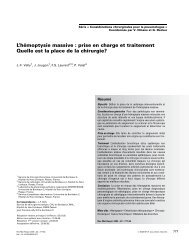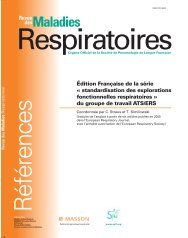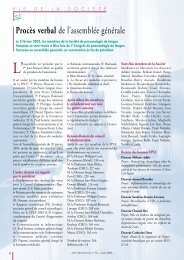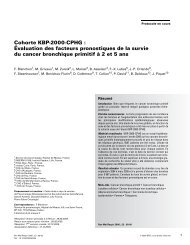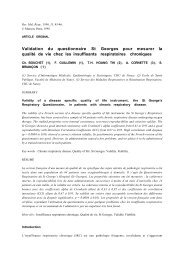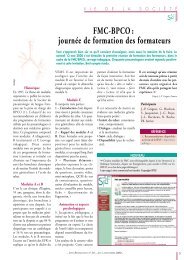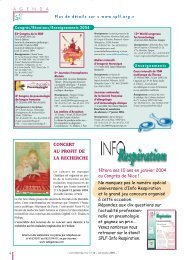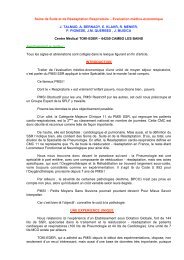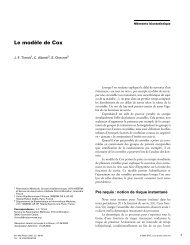Aspergillose pulmonaire aiguë invasive et pathologies ... - SPLF
Aspergillose pulmonaire aiguë invasive et pathologies ... - SPLF
Aspergillose pulmonaire aiguë invasive et pathologies ... - SPLF
Create successful ePaper yourself
Turn your PDF publications into a flip-book with our unique Google optimized e-Paper software.
<strong>Aspergillose</strong> <strong>pulmonaire</strong> aiguë <strong>invasive</strong> <strong>et</strong> <strong>pathologies</strong> <strong>pulmonaire</strong>s chroniquesl’amphotéricine B désoxycholate sont une alternative. Parmiles échinocandines, la casponfongine se positionne dans lesaspergilloses réfractaires. L’évaluation d’une bithérapie antifongiqueen phase aiguë est en cours. Parallèlement <strong>et</strong> autantque possible, la question de la décroissance ou de l’arrêt descorticoïdes doit être discutée. Enfin, on insistera sur la nécessitéde demander plus d’examens autopsiques, en particulierchez les patients décédant d’une pneumopathie extensive nondocumentée ou quand le diagnostic est fortement suspectémais non confirmé.À RETENIR• L’incidence de l’aspergillose <strong>pulmonaire</strong> aiguë<strong>invasive</strong> est vraisemblablement sous-estimée, enparticulier en cas de pathologie <strong>pulmonaire</strong> chronique.• Le facteur de risque majeur, outre la neutropénieprofonde, est la corticothérapie au long cours.• La fongicidie physiologique se fait en plusieursétapes : reconnaissance, fixation, puis destructiondes spores par le système immunitaire.• En cas d’anomalie de la phagocytose, les sporesgerminent <strong>et</strong> donnent naissance à des filamentsaspergillaires ou hyphes qui possèdent le pouvoirinvasif pathogène.• Dans un cas sur deux, la mise en évidence de filamentsaspergillaires dans les expectorations <strong>et</strong>/oules aspirations trachéales témoigne d’une maladieaspergillaire évolutive.• L’examen direct ou l’apparition en culture de filamentsaspergillaires sur le LBA est un argumentpositif décisif pour la mise en route d’un traitement.• L’antigénémie aspergillaire a une sensibilité <strong>et</strong> unespécificité globales proches de 90 % en cas d’hémopathiemaligne, mais on ne dispose que de peu dedonnées dans les autres affections.• Le pronostic de l’aspergillose <strong>pulmonaire</strong> aiguë<strong>invasive</strong> est plus sombre chez les patients atteintsde pathologie <strong>pulmonaire</strong> chronique qu’en casd’hémopathie maligne.• La monothérapie antifongique reste la règle enpremière intention, mais on peut opter pour unebithérapie dans les formes menaçantes.Références1 Steinbach WJ, Stevens DA, Denning DW, Moss RB : Advancesagainst Aspergillosis. Clin Infect Dis 2003 ; 37 : S155-6.2 Philippe B, Germaud P : <strong>Aspergillose</strong>s chez l’immunocompétent.Vers une nouvelle classification ? Rev Mal Respir 2005 ; 22 : 711-4.3 Groll AH, Shah PM, Mentzel C, Schneider M, Just-Nuebling G,Huebner K : Trends in the post-mortem epidemiology of <strong>invasive</strong>fungal infections at a university hospital. J Infect 1996 ; 33 : 23-32.4 Vogeser M, Wanders A, Haas A, Ruckdeschel G : A four-year reviewof fatal aspergillosis. Europ J Clin Microbiol Infect Dis 1999 ; 18 :42-5.5 Thommi G, Bell G, Liu J, Nugent K. Spectrum of <strong>invasive</strong> pulmonaryaspergillosis in immunocomp<strong>et</strong>ent patients with chronic obstructivepulmonary disease. South Med J 1991 ; 84 : 828-31.6 Rodrigues J, Niederman MS, Fein AM, Pai PB : Nonresolving pneumoniain steroid-treated patients with obstructive lung disease. Am JMed 1992 ; 93 : 29-34.7 Rello J, Esandi ME, Mariscal D, Gallego M, Dominguo C, Valles J :Invasive pulmonary aspergillosis in patient with chronic obstructivepulmonary disease: report of eight cases and review. Clin Infect Dis1998 ; 26 : 1473-5.8 Bulpa PA, Dive AM, Garrino MG, Delos MA, Gonzales MR,Evrard PA, Glupczynski Y, Installé EJ : Chronic obstructive pulmonarydisease patients with <strong>invasive</strong> pulmonary aspergillosis: benefits ofintensive care? Int Care Med 2001 ; 27 : 59-67.9 Ader F, Nseir S, Le Berre R, Leroy S, Tillie-Leblond I, Marqu<strong>et</strong>te CH,Durocher A : Invasive pulmonary aspergillosis in chronic obstructivepulmonary disease: an emerging fungal pathogen. Clin MicrobiolInfect 2005 ; 11 : 427-9.10 Lin SJ, Schranz J, Teutsch SM : Aspergillosis case-fatality rate: systematicreview of the literature. Clin Infect Dis 2001 ; 32 : 358-66.11 Meersserman W, Vandecasteele SJ, Wilmer A, Verbeken E,Pe<strong>et</strong>rmans WE, Van Wijngaerden E : Invasive aspergillosis in criticallyill patients without malignancy. Am J Respir Crit Care Med2004 ; 170 : 621-5.12 Ascioglu S, Rex JH, de Pauw B : Defining opportunistic <strong>invasive</strong> fungalinfections in immmunocompromised patients with cancer andhematopoi<strong>et</strong>ic stem cell transplants: an international consensus. ClinInfect Dis 2002 ; 34 : 7-14.13 Vandewoude KH, Blot SI, Depuydt P, Benoit D, Temmerman W,Colardyn F, Vogealers D : Clinical relevance of Aspergillus isolationfrom respiratory tract samples in critically ill patients. Congress abstract,44 th Interscience Conference on Antimicrobial Agents andChemotherapy, Washington, USA, October 30-November 2, 2004.14 Garnacho-Montero J, Amaya-Villar R, Ortiz-Leyba C, Leon C,Alvarez-Lerma F, Nolla-Salas J, Irur<strong>et</strong>agoyena JR, Barcenilla F : Isolationof Aspergillus spp. From the respiratory tract in critically illpatients: risk factors, clinical presentation and outcome. Crit Care2005 ; 9 : R191-R199.15 Dimpoulos G, Piagnerelli M, Berre J, Eddafali B, Salmon I,Vincent JL : Disseminated aspergillosis in intensive care unit patients:an autopsy study. J Chemother 2003 ; 15 : 71-5.16 Di Stefano A, Capelli A, Lusuardi M, Balbo P, Vecchio C,Maestrelli P, Mapp CE, Fabbri LM, Donner CF, Sa<strong>et</strong>ta M : Severityof airflow limitation is associated with severity of airway inflammationin smokers. Am J Respir Crit Care Med 1998 ; 158 : 1277-85.17 Schaffner A : Therapeutic concentrations of glucocorticoids suppressthe antimicrobial activity of human macrophages without impairing© 2006 <strong>SPLF</strong>, tous droits réservés 6S19



